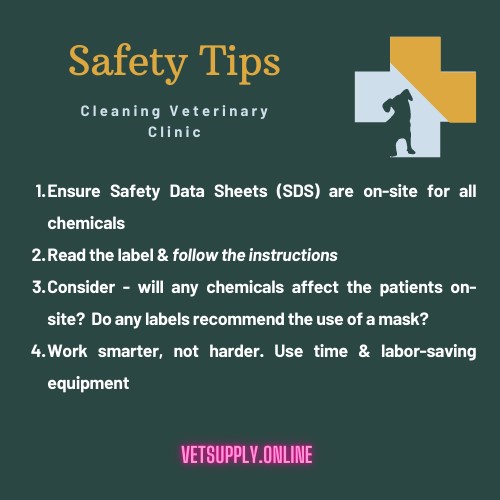Safety Is A Priority When Cleaning Veterinary Clinics
1st Aug 2023
We often hear the adage “measure twice, cut once” – a saying that means to plan and prepare with care prior to taking action. However, when it comes to cleaning unfortunately, cleaning can often feel like an afterthought – after a long day, “[we] just want to finish this and get out of here.” This is when mistakes occur that can have a great negative impact on the veterinary clinic. How then should a veterinary clinic prioritize safety in their cleaning program? Let’s go through it.
Whether the veterinary clinic has a new member to the team who will be assisting with the cleaning or if it’s an established team that has been managing the cleaning program, it is best practice for the clinic to check in and test their established team (and ensure documented training is done for new team members) on the following on regular intervals, as determined by the veterinary clinic.
Are the Safety Data Sheets on-site for all chemicals?
On a frequency determined by the veterinary clinic, the team should do an inventory of all chemicals and ensure that there are SDS sheets on-hand for all chemicals. If there are chemicals on-hand that are no longer used, these chemicals should be discarded with proper care. Only chemicals that are being used in the cleaning program should be on-hand.
All veterinary clinic staff – be it whether they handle the cleaning or not – should know where the Safety Data Sheets (SDS) are stored. These must be stored in an easily visible place. The SDS sheets should also be near the eyewash station. In the unforeseen event where a team member gets a chemical in the eye, fellow team members should be trained on getting the affected team member to the eye wash station while another member looks up on the specific chemical’s SDS sheet to know what steps should be taken.

Reading the label & following the instructions
As a generalization, everyone knows what bleach is. That said, people without reading the label and following the instructions on occasion will mindlessly mix bleach with other cleaning agents that results in a noxious gas that will have a harmful effect. The idea being that we know what bleach does and we know what “X” cleaning agent does, maybe the combined effect will help to knock this cleaning job out. Well, it can have the effect of knocking you out or worse.
Reading each label of the chemicals and following the instructions is key to ensuring not only safety but ensuring the success of the cleaning process. As a for instance, you don’t want to spray acids around metals that will etch. As another for instance, just because one person likes the smell of lavender, doubling up on your favorite general purpose cleaner doesn’t mean the surface will be “double” clean. The bottom line is reading each label and following the instructions will prevent preventable mishaps.
Will any chemicals affect the patients?
In reading the label of the chemical, does the manufacturer recommend the use of a mask? If this is the case, it is important to consider that if the aerosolized chemical will negatively impact the team cleaning, this will also bother any of the patients at the veterinary clinic. Depending on the application, the label will point out the dilution rate through an auto scrubber or foaming tool. It is advisable when reading the labels, to find the best application of the chemicals within the cleaning program with the health of the patients in mind. Sometimes, it can be as simple as switching from a standard trigger sprayer to a foaming trigger sprayer. The most important thing is to read the label and come up with the best solution for the veterinary clinic with patient health in mind.
Work Smarter, Not Harder
Most accidents occur when people are tired and trying to get a task done too quickly. Lifting a mop bucket full of dirty water at the end of a shift can strain someone’s back. It is advisable to use time and labor-saving equipment like an auto scrubber. While yes, an individual will still have to dump out the dirty water in the auto scrubber, it is generally as easy as dumping out the water via the dump hose. On top of which, a person operating the auto scrubber will have cleaned the surface in significantly less time.
This is not to say a mop does not have it’s place in a veterinary clinic. There is a time and place to use a mop. There is also a time and place to use an auto scrubber. A mop is perfect for unexpected messes by animal patients or puddles of water tracked into the clinic on a rainy day. An auto scrubber is perfect for cleaning the floor when the entire floor surface is scheduled for cleaning.
Testing and Documenting Safety Compliance
It is important for the veterinary clinic to test their team on safety around the chemicals used in their cleaning process. Within each of these points above, training and documentation can be created to ensure the team is in fact working with safety in mind as the priority. In following the points, the veterinary clinic staff should be able to answer questions about the cleaning program with relative ease.
In prioritizing safety when cleaning in the veterinary clinic, the practice will be able to reduce their risk and exposure tremendously. Accidents and patient illnesses due to negligence generally are just the tip of the spear – incidences on the back of no oversight and/or training of safety guidelines. No matter how well a cleaning program appears to be managed, it is best practice for a veterinary clinic to test, and review, and provide trainings as necessary to ensure the program is not only being properly adhered to, but adhered to with safety as the priority.


